The basic idea of a shotgun was devised in the 16th century with firearms such as fowling pieces and the blunderbuss. With those muzzleloading designs slowly transitioning into more modern designs like the double barrel shotguns in the mid-nineteenth century. Quickly transitioning into pump action designs in the early 1890’s. Creating that famous ‘cha-chunk’ sound.
The concept of the shotgun is as old as the invention of firearms itself. But with such a long history and legacy of designs. Talking about shotguns is quite a versatile topic. Which I’ve decently tried to cover in this exhilarating and comprehensive Shotguns 101 guide.

However, if you are interested in learning about some specific aspect. Take a look at this table of contents as a quick catalog.
Part 1 – Shotgun Basics
Familiarize yourself with the basics of a shotgun as the first step of learning about these powerful guns. The clearer the basics, the better your overall understanding.
What Is The Difference Between a Rifle and a Shotgun?
Okay, so to make things clear. We’ll understand it from a technical and also a legal standpoint.
Legal Differences
Technically a rifle and a shotgun with a stock are long guns. Now, a long gun is any firearm that can be held against the shoulder and fired with both hands holding it. Or in legal terms, a firearm with a minimal overall length of 26 inches or a minimum barrel length of 16 inches.
Also legally, if a long gun has an overall length less than 26 inches. It is considered a SBR (Short Barreled Rifle) in terms of rifles, with a minimum barrel length of 16 inches, requiring extra paperwork. For Shotguns, it’s called an SBS (Short Barrel Shotgun), with a minimum barrel length of 18 inches and also requires paperwork. These shouldn’t have a stock attached to them. Keep in mind, laws also differ from state to state on these.
Technical Differences
A shotgun is intended to be a smooth bore weapon. Meaning that the barrel should be plain on the inside. Whereas a rifle has grooves inside the barrel. These grooves are known as rifling, and it has a lot to do with accuracy. More on that later.
There are two prominent technical differences: the ammo and intended use.
Shotguns, since their modern beginning, used different kinds of ammunition compared to a rifle. While a rifle was designed to use a single projectile with the aim to enhance accuracy. Shotguns use shotshells which hold multiple pellets or metal balls.
When a shotshell is fired, the gunpowder charge pushes these pellets out of the casing. As they move through the barrel, these pellets spread upon exiting the barrel. Creating a larger area of impact compared to a single bullet.
The area in which these pellets spread is controlled by a muzzle device called a choke. Which is a more detailed discussion in itself. Additionally, the size of these pellets inside a shotshell categorizes different kinds of shotgun ammo.

Since multiple pellets exit when a shotgun is fired. The range of these pellets is limited since the total power gets distributed among a number of pellets rather than a single projectile. Plus, the effect of air drag also limits the range.
Hence, shotguns are used for hitting targets at close range. Or targets which move quickly and a barrage of pellets is the best way to cover a patch of area. Like in sports such as wing shooting (duck hunting) or clay pigeon sports.
Shotguns deliver a decimating damage at short ranges. Which is why shotguns are preferred as home defense weapons by civilians and breaching weapons in combat by military forces.
However, it is also important to note that shotguns with rifled barrels are also quite prevalent. These shotguns are used to fire slugs or sabot slugs. These slugs are single projectiles that look like a bullet and may or may not have grooves on them.
Rifled barrel shotguns are used for applications like hunting deer or big game beyond 50 yards. Or as anti-armor ammunition in some cases. Some states require hunters to use shotgun slugs in some populated areas.
On the other hand, rifles can be used for any application from short to long and extreme long ranges. Sniper’s use rifles and targets have been knocked down at distances more than a couple of miles by military snipers.
Types of Shotguns
For a quick index, below are the different types of shotguns that you can find on or off the market. Shotguns can be classified based upon their action. Which further decides their rate of fire, controllability and suitable applications.
Break-Barrel Shotguns
These are the earliest types of modern shotgun designs. As the name suggests, a break-barrel shotgun requires you to break open the barrel and load/extract a shell from the breech. These shotguns can have a single or a double barrel configuration. There are also a few retro and uncommon designs featuring three and even four barrels.

Double barrel shotguns can be further classified into two design types. The side by side shotgun and the over/under shotgun (a.k.a stacked-barrel). Again, as the name suggests. A SxS shotgun has barrels positioned horizontally. Whereas an O/U shotgun has barrels stock one on the top of another.
SxS shotguns were very popular as stagecoach guns and carriage defense weapons back in the times of the ‘wild west’. These shotguns can further be classified based upon their trigger and action. Which can be a sidelock or a boxlock.
O/U shotguns are more preferred by competitive shooters for clay shooting sports like trap and skeet. These offer excellent accuracy when swinging the gun for shooting moving targets. Plus, they have a single aiming point for both barrels.
Break barrel shotguns have a lot of class associated with them. Some unique or antique pieces can cost hundreds of thousands of dollars.
Another less talked about variant of break-barrel shotguns is a sawed-off shotgun. That is created by shortening the barrels of (mostly) a double barrel shotgun. Making it more concealable. Historically it was used for criminal activities by burglars and the mafia. These shotguns are illegal to possess.
Lever Action Shotguns
A less popular version of shotguns are lever actions. These came into being when lever action rifles were famed all over America in the late nineteenth century. Shotguns such as the Winchester Model 1887 and Henry Lever Action in .410 are still available for gun enthusiasts.
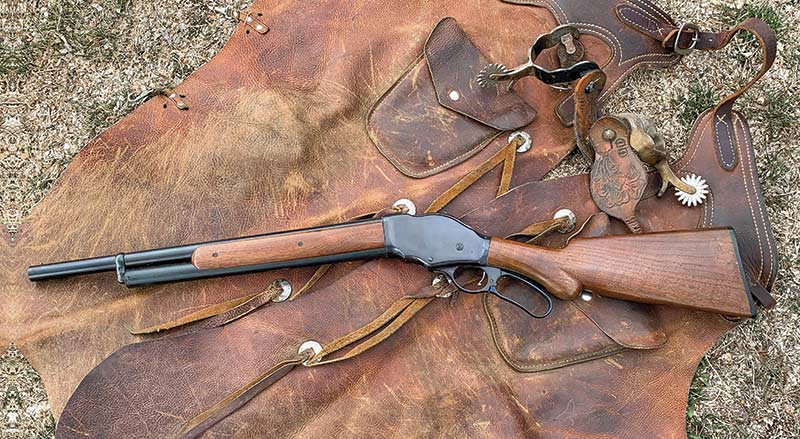
But such shotguns aren’t very practical. Especially for heavy gauges like the 20 and 12. Plus, to be honest, .410 is not a very viable hunting round in general.
Pump Action Shotguns
The most common and stylish type of shotgun that exists today. This is the iconic design that has crazed numerous hollywood fans across decades. With that cool lever racking sound.
The invention of the pump action shotgun is credited to the legendary J.M Browning who came up with the Model 1893 shotgun. Which further transformed in the model 1897 and collected a lot of recognition as the ‘trench gun’ in World War I.
A pump action shotgun works pretty much the same as a lever action. The shells are housed in a tubular magazine beneath the barrel. Racking the pump backwards disengages the spent shell from the chamber and ejects it. Whereas racking it back forward pulls up a new round and slams it inside the chamber.
These shotguns are extremely popular because they are super-inexpensive and really easy to maintain. You can go for months or even years without cleaning the shotgun (although that’s not recommended) and it will still work. That’s because the action is fully manual, and a smooth bore doesn’t accumulate too much grime.
This reliability and low price tag has made pump actions like the Remington 870 and Mossberg 500 the most owned firearms in the U.S for self defense. Even the military uses pump actions and the law enforcement departments also use them as riot guns.
Semi-auto Shotguns
Semi-auto shotguns were introduced in the late 1890’s and the first commercially successful of them was the Browning A-5. These shotguns can be gas or recoil operated with each of them having their own pros and cons. Especially relating to accuracy and generated recoil.
These shotguns are mostly preferred by duck hunters as they offer a faster rate of fire for quick follow up shots. Models like the Benelli M4 are extremely popular in the military and also in shooting sports.
Since there’s no slide to rack on these shotguns. These can be very suitable for some tactical applications like urban combat. Where a quick rate of fire and prone shooting can be crucial.
There’s also a type of semi-auto shotgun known as the revolver shotgun featuring a rotating cylinder to hold shells. Some examples are Colt Model 1839 and in modern times the Armsel Striker.
Full-auto Shotguns
These shotguns are extremely unlikely to be found in large scale use. They are more of a novelty item. The two most common full-auto shotguns available today are the AA-12 with a drum mag and the Saiga 12 with a straight mag.
These shotguns are less controllable and have no practical uses in civilian life. But you should know that these exist.
Part 2 – What To Know Before Buying a Shotgun
So, you know the basics now. Maybe your fingers are itching to count some money out of your wallet and go buy a shotgun for your intended purpose. But wait for a few more minutes. Directing your attention to this section to be aware of the actual points before buying a shotgun.
How to Choose a Shotgun
The first and most basic question that should be answered before choosing a shotgun is: What will be its purpose?
Is it going to be used for hunting? Or will it spend its days inside a case as a home defense weapon? Or maybe it will be used for more professional applications like competitions?
Otherwise, one may also be looking for a general purpose shotgun. The jack of all trades, but the master of few.
Let’s cover some different use case scenarios taking into consideration the following factors:
- Action Type
- Barrel Length and Rifling
- Design Type
- Shooter Size/weight
- Gauge
- Customizability
- Chokes
- Ammo Capacity
- Price
Action (Pump, Semi-auto, Lever, or Break-Action)
It’s clearly evident from gun-ownership data that pump actions are the most commonly owned shotgun action. This design allows controllability and a check on your rate of fire. Along with extra safety. Since the pump has to be worked to cycle a round.
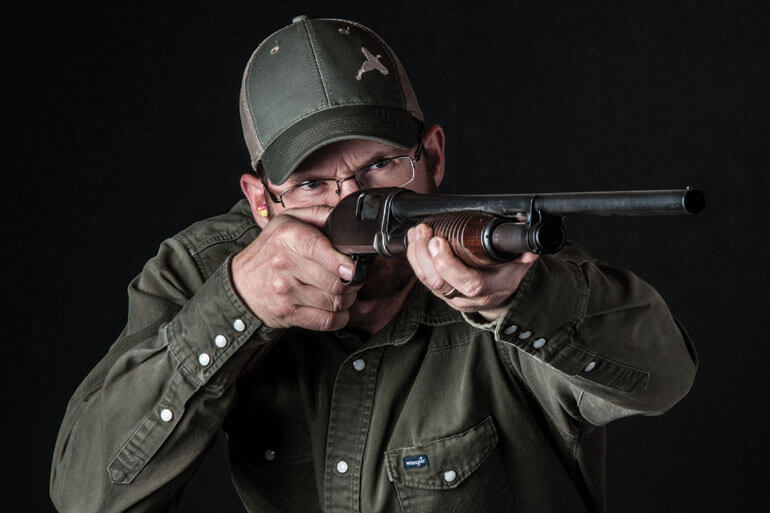
However, on the other hand, the racking sound of a pump action can attract attention in a hunting or home defense scenario. So beware of that.
Next comes the semi-auto shotgun. These are widely used for duck hunting due to their rate of fire. These are also viable for home defense due to their silent operation. But pumps are still more preferred.
Lever action shotguns aren’t very popular and have limited use. Whereas break action shotguns are best for competitions, traditional style hunting and reenactment events.
Barrel Length and Rifling
Longer barrels are more preferred for longer distances. That’s the general rule of thumb. The same goes true for a shotgun. Shorter barrels are more useful for applications like hunting, combat and home defense.
Longer barrels deliver better swing for the barrel and tracking moving targets. Along with the benefit of better accuracy. So longer barrels are mostly preferred for hunting birds and clay shooting sports like trap and skeet. But also remember that the longer the shotgun is, the more clumsy the handling and heavier it will be.
Another important factor to consider is the rifling of the barrel. Most shotguns come with a smooth bore barrel. Which is great for short to medium range. But when pellet shots like buckshot or birdshot are fired from a rifled barrel, it will lose its pattern density and accuracy to some extent.
On the contrary, you can shoot slugs through a smooth bore barrel. Except for sabot slugs.
Shotgun Design/Type (O/U / SxS / single-barrel / bullpup)
Over/under shotguns are mostly used for trap and skeet clay pigeon competitions due to their stacked barrel design. Side by Side (SxS) styles are more of hunting and heirloom shotguns.
Single barrel shotguns are great for educating beginners about shotguns and also enhancing the thrill of hunting with just one shot.
Bullpup shotguns are the new kid on the block and suit tactical roles for the military and law enforcement. However, you can use them as home defense weapons or to diversify your gun collection. BTW, these tactical shotguns are great for home defense since you can add accessories more easily.
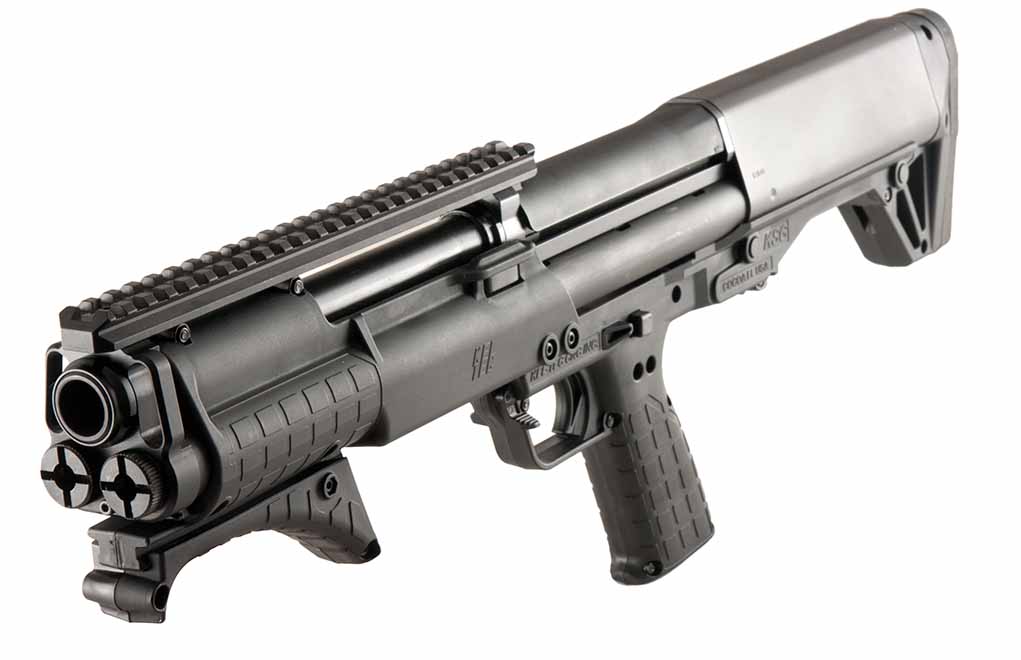
Shooter Size & Weight
It is crucial to ensure that the size and weight of a weapon suits the user. Which in this case is the LOP and weight of the shotgun. LOP stands for Length of Pull and it refers to the distance between the stock end and the trigger.
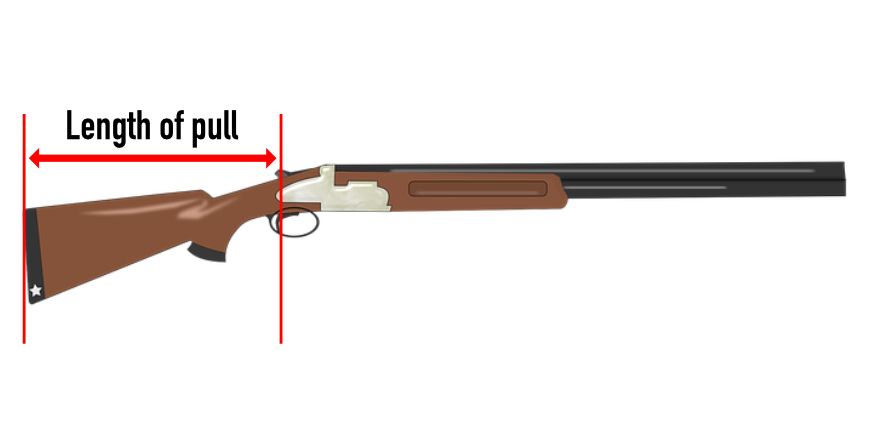
Smaller people, children and women are generally comfortable with smaller LOP shotguns due to their size. Whereas normal adult males prefer normal 14-14.5 inch LOP’s. Some users with longer arms may prefer longer stocks or accessories like extendable stock, stock spacers or LOP altering recoil pads.
Individuals with lower upper body strength may also not be able to comfortably hold a heavy shotgun accurately. These individuals should look for shorter barrels and lower ammo capacity options. Our review of the best youth shotguns or shotguns for women may be of interest to you here.
Gauge
We’ll delve deeper into this topic in the next section. But for a general overview, the smaller the gauge, the more power and power a shotgun will have. Generally speaking, gauge to a shotgun is what caliber is to a rifle. The most common shotgun gauges are 12, 16, 20 and .410.
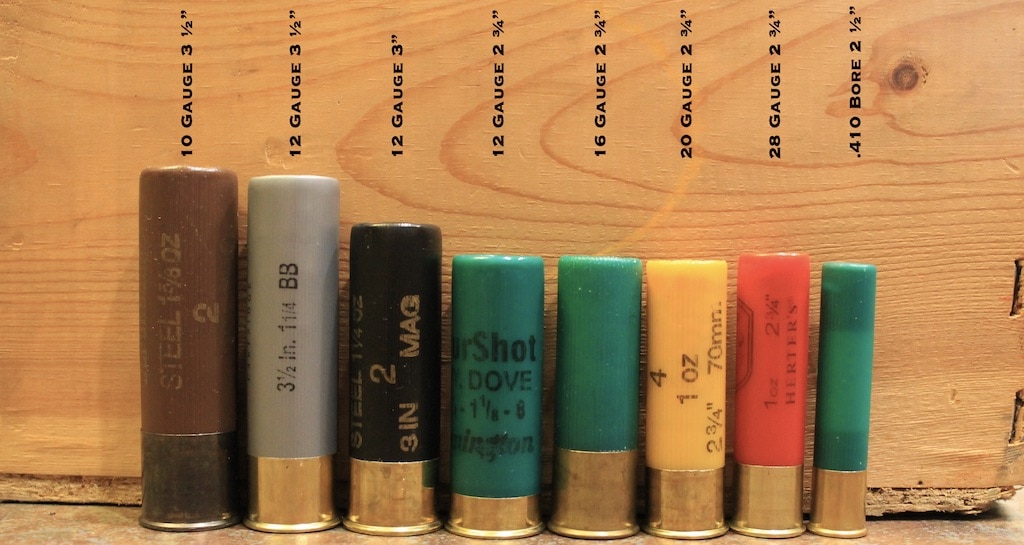
12 gauge has high recoil, but also the most power. It is widely used for hunting, home defense, law enforcement and combat. Choosing the appropriate ammo type.
20 gauge shotguns are more suited for recoil sensitive shooters and can be used for hunting birds, home defense and competitions. The 16 gauge is somewhat between the 12 and 20 gauge.
The least powerful gauge is the .410. Which is technically a bore and not gauge (explained further). It is mostly used for training beginners, plinking and hunting small game and varmints.
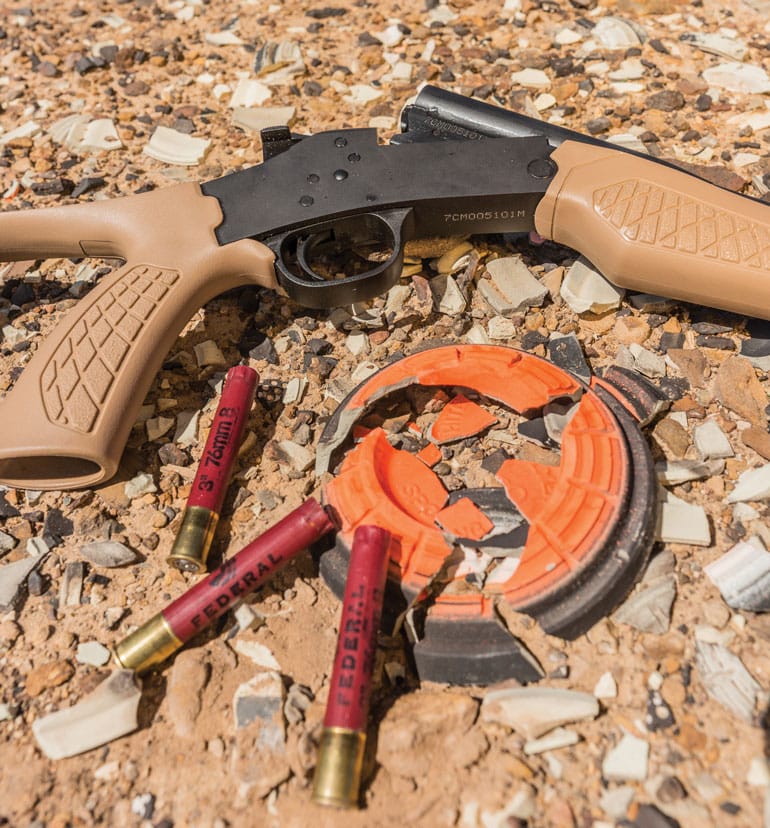
Customizability
This trait is not common for shotguns. But justifiably desirable in the modern context. When there are many accessories that can be used with firearms. Shotguns generally feature a basic design. But some manufacturers offer customizability in their shotgun along the likes of an AR.
Pistol grips, adjustable stocks, lights, railed handguards, slings, folding sights and top rails are some customizable features you can opt for when buying a shotgun. Making the weapon more ‘tactical’ or ‘tacti-cool’.
Chokes
A shotgun choke or choke tube is a muzzle device that controls the spreading pattern of the pellets exiting a barrel. There are five types of chokes, namely: full, improved modified, modified, improved cylinder and cylinder.
You should mostly look for a shotgun that allows you to interchange chokes. Unless you are very specific about your application and the type of choke you want to use. Like if you want to use your shotgun only for home defense.
Ammo Capacity
The number of shells your shotgun can hold will determine your chances to succeed in a life threatening situation like home-defense. Combat, defense, competitions (like 3-gun) and range practice may require higher capacities. Whereas hunting can be done with a couple of rounds.
You must be aware that shotguns with a capacity of no more than three shells (2+1) are only permitted for waterfowl hunting in the U.S.
Price
The price of a shotgun is not always a concerning factor. That’s because simple pump action shotguns tend to be pretty inexpensive. Easily found for less than a couple hundred dollars. But semi-automatics can be expensive and cost you upwards of $1,000.
The most expensive are double barrel shotguns. Especially over/under that are used for shooting sports. Make sure you don’t buy an expensive piece that you have no use for.
Part 3 – Shotgun Ammo
The ammo is the fodder of a firearm. Like rifles, shotguns also have a wide range of ammo options available. Let’s take a look at it in detail. Scouring the common and uncommon options.
Understanding Shotgun Gauge
Gauge for a shotgun is what ‘caliber’ is to a rifle or handgun. Back in the day, people had to buy lead to mould their own ammo. So the ‘gauge’ of a shotgun is the number of lead balls equal in diameter to the inner diameter of the barrel that can be made from one pound of lead. So a 12 gauge shotgun has a barrel diameter equal to 12 balls of lead made from one pound.
You may also encounter the term ‘bore’ which is the British version of ‘gauge’ in some way. Luckily, science and industry has advanced so much that you need not bother about moulding your shotgun ammo.
The shotgun gauges available today in the U.S are 4, 8, 10, 12, 16, 20, 28 and .410 bore. The 4, 8 and 10 gauges are super-rare and even illegal in some places. The most popular gauges are 12 and 20.
Shot Size
Shotgun shells contain small balls of metal inside them which are called shots. The diameter of these shots varies in different types of shotgun shells. But all these pellets inside a single shell will be of the same size.

These are further classified into buckshot and birdshot. Where buckshot shells have larger diameter pellets in lesser numbers (6-10). Whereas birdshot features smaller pellets but in a larger quantity.
Buckshot is more powerful and delivers a tighter pattern. Birdshot is suitable for covering a larger area and deals lesser damage due to smaller size and larger impact area.
The diameter of these shots is mentioned by a number. The bigger the number, the smaller the pellet size.
These numbers for birdshot are are 000 (0.190 inches diameter), 00, 0, #1, #2, #3, #4, #5, #6, #7, #7-½, #8, #8-½, #9 and #10 (0.070 inches diameter).
Whereas common buckshot sizes include #000 Buck (0.36 inches), #00 Buck, #0 Buck, #1 Buck, #2 Buck, #3 Buck and #4 Buck (.240 inches).
Shots were traditionally made from lead. But since it is a toxic element, lead shots are banned for hunting waterfowl to prevent polluting water bodies. The latest metals that are used for manufacturing shots are steel, bismuth, tungsten-nickel-iron alloys or tungsten-polymer blends.
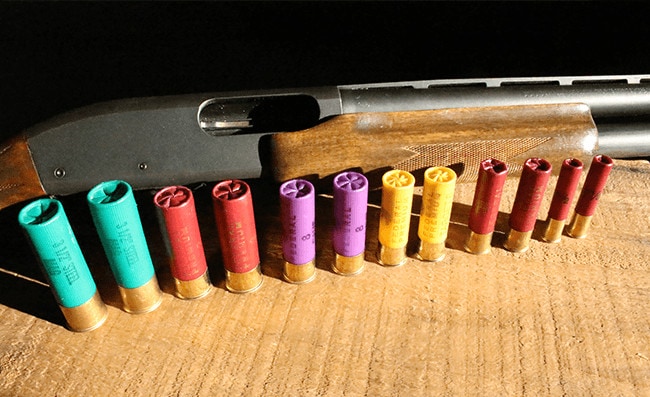
The most common shotgun shell lengths are 2.5”, 2.75”, 3” and 3.5”. As a matter of fact, you can shoot a shorter shell from a shotgun chambered for longer shells. But the reverse is not possible. Also make sure to shoot the right shell length from a barrel to avoid unwanted damage.
The appropriate shell length for a barrel can be found stamped on its base.
Magnum or Low Power Shells
Like rifle calibers, shotgun shells can also have regular or magnum capacity. In terms, magnum means that a shell may either be loaded with more gunpowder or with more pellets. Or maybe both at once.
Magnum shells operate at much higher pressure than regular shells. So it is important to check whether your shotgun is rated to handle magnum shells or not. Magnum shells are mostly used by hunters to take down dangerous big game. Or to increase the range of the shot.
There’s also an option to choose from low recoil shells which can sometimes be smaller in length (almost half than regular shells). Allowing them to be inserted in higher capacity in regular sized magazines.
Alternative Ammo
There’s a wide range of alternate ammunition to choose from when shotguns are concerned. These can be classified into non-lethal and lethal categories.
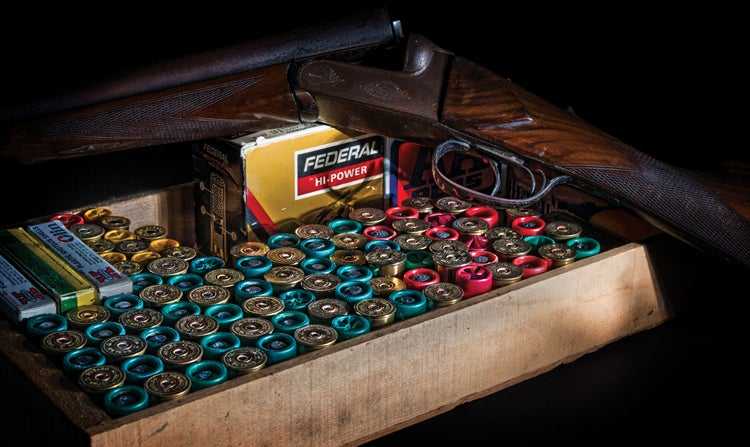
Less lethal shotgun rounds are used for riot and animal control. These include flexible baton rounds, gas shells, rock salt shells, rubber slugs, breaching rounds, bird bombs, screechers and blank shells.
Specialty ammunition for the lethal category includes foster type slugs, flechette rounds and grenade rounds. You can also find some novel shotgun ammo like dragon’s breath and bolo rounds.
In fact, there’s a type of shotgun shell that cleans the barrel when fired.
Part 4 – Popular Shotgun Manufacturers
Let’s take a look at the most popular shotgun manufacturers in the American and also the global market. There are companies other than these to choose from. But these are still the most prominent and acclaimed ones.

Remington
Now who doesn’t know the name of Remington. Especially in the shotgun world. The Remington 870 is the most owned shotgun in the U.S. Plus, there are other options down their line to choose from. The company was founded in 1816 and is the oldest gun manufacturer in the U.S. Remington also owns Marlin firearms and Parker Bros. A very famous name in the shotgun world.

Winchester
Winchester is also one of the oldest firearm manufacturers in the U.S. The famed ‘trench gun’ that gained popularity in WWI is a product from their factory. The company has a lot to offer, ranging from budget shotguns to pricey over and unders. While the original company went defunct in 2006, their brand name still continues.
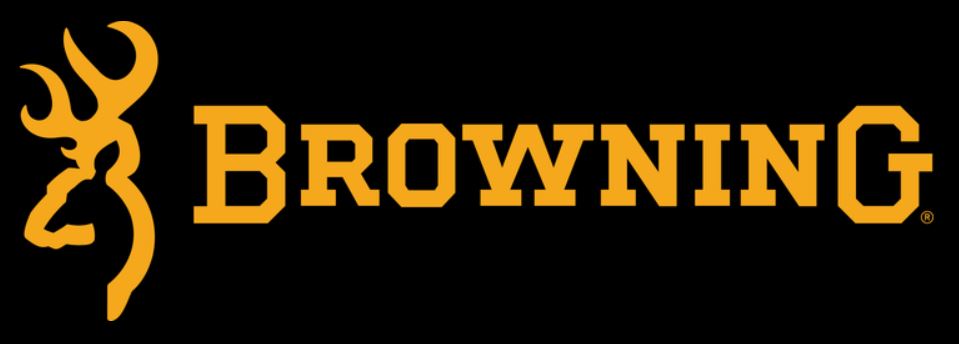
Browning
John Browning, the innovative inventor of the designs of many modern firearms, separated from Winchester in 1880 and founded his own company. The Browning Arms Company. Browning is known for the first successful semi-auto shotgun, the Browning 5. With many other prominent shotguns in their line like the Citori o/u, BPS, Cynergy o/u and many others. This is also a fully American company.

Beretta
Beretta is an Italian firearms manufacturer that is also a renowned global weapons manufacturer and supplier to many armies. Their shotguns are known for their meticulous craftsmanship and class. Their shotguns are very durable and with many models mostly loved by upland bird hunters and competition shooters.

Benelli
While Benelli is a subsidiary of Beretta. It made to this list because of its popular shotguns like the M4 which is an amazing tactical shotgun. Plus, models like M2 which are blindly trusted by bird hunters. The Benelli M3 is also a rare masterpiece that can be converted from semi-auto to pump action.

Mossberg
Just following Remington is the Mossberg 500 shotgun in sales and ownership. Mossberg shotguns are officially used by the U.S Army and many LE departments across the country. The company O.F Mossberg & Sons specializes in manufacturing shotguns and has a wide range of options to choose from.

Ithaca
An old but reliable American firearms manufacturer that came into existence in 1880 in New York. The company became famous for its model 37 shotgun. Which is still bought by many beginners and budget buyers to test their hands on shotguns.
Purdey – aka James Purdey & Sons
A British gunmaker based in London and renowned for holding three Royal Warrants of appointment as gun and rifle makers to the British and other European royal families. Their shotguns are literally masterpieces and very unique. Purdey also sells some of the most expensive break-action shotguns costing above 100,000 pounds in value.
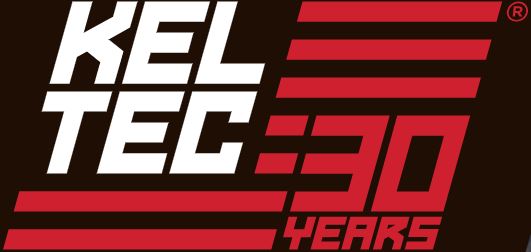
Kel-Tec
Kel-Tec CNC Industries Inc. is an American firearm manufacturer based in Florida. The company became famous for its bullpup tactical shotgun, the KSG. Especially from the movie ‘John Wick’. It is available in single and double tube variants.
Part 5 – Shotgun Care & Maintenance Tips
Just like personal hygiene is extremely important. So is maintaining and taking care of firearms on a regular basis. A well-maintained shotgun will perform flawlessly and as expected. Whereas a dirty shotgun is prone to jamming or degraded performance. You sure don’t want that, especially in real-life defense situations.
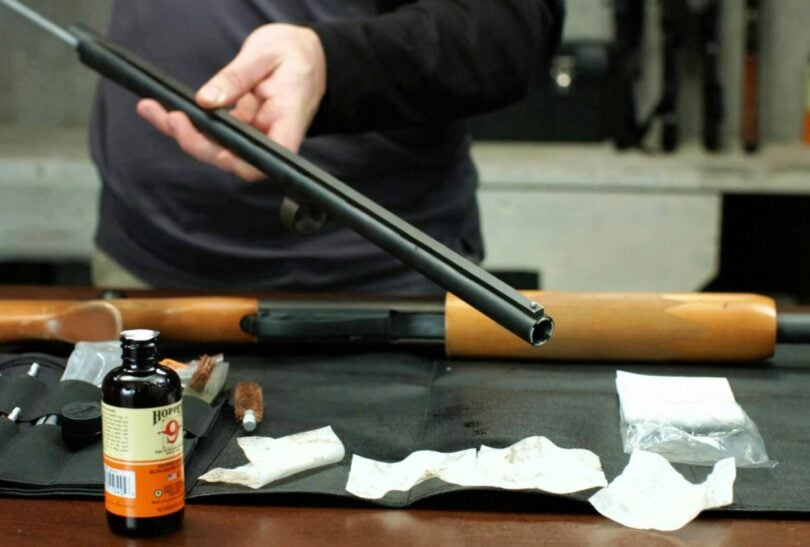
How to Clean a Shotgun
Most shotguns are fairly easy to disassemble. Plus, cleaning different types of shotguns is almost a similar procedure. Whether it is a break-barrel, semi-auto or pump action shotgun. But before you plan on disassembling your shotgun, make sure you know how to put it back together. Either with the help of a manual/video or with your knowledge.
How to Clean a Shotgun
- Gather the Necessary Tools
You can opt for a dedicated shotgun cleaning kit that suits the gauge of your shotgun. Or you may also buy a universal cleaning kit that includes brushes, boresnake, rods of appropriate size and cleaning patches/swabs. Also get a good lube and a good gun cleaning oil (like Hoppe’s No. 9). Along With a toothbrush
- Disassembly
Stripping apart a shotgun is pretty easy and mostly doesn’t require any tools. Unless you’re planning on dismembering the trigger assembly. The most important part of the shotgun that needs cleaning is the barrel, followed by the action. Rest everything needs superficial cleaning. Also remember to remove the choke and give it a thorough treatment.
- Clean the Barrel
The barrel can be easily pulled out from a shotgun, regardless of its type. Once the barrel is out, mount the cleaning rod with a bronze brush of appropriate size and push it to and fro from the muzzle end. All the way out of the barrel. Repeat this 3-4 times to loosen up the grime inside. You may see some of it exiting the muzzle as powdery smoke.
Now dip a cloth patch in a cleaning solvent, mount it on the rod with the appropriate jig and work it through the barrel. Do this two times more with new patches. After that, run a couple of dry patches unless you see them coming out clean. - Clean the Action
Once you’re done cleaning the barrel, shift your attention towards the action. Use a small toothbrush to scratch-off any dirt or detritus from the action. Including any finer brushes for the grooves. Use some WD-40 if you encounter any components rusting or are difficult to clean. Do not disassemble the trigger assembly if you don’t know how to put it back. Especially in break-action shotguns.
- Lubing and Wipe-Down
Once the gun has been thoroughly cleaned, apply gun lube at appropriate points. But in a very limited quantity. Since it may heat up under operation and cause jamming issues. Wipe off any excess oil from surfaces and assemble the gun back.
Now apply a little coat of gun oil on the exterior surfaces using a rag. If your shotgun has a wooden stock, oil is gonna be very important. But again, use it in low quantities and wipe off the gun thoroughly after.
How Often Should I Clean My Shotgun?
The answer to this question varies along the lines of usage and storage. Not cleaning your shotgun, especially if you use it often. Will result in frequent malfunctions and also the degradation of the firearm’s wood and metal.
Issues such as misfeeds, loss of accuracy, jamming, ejection problems can be very hampering the overall performance of the shotgun. It is a machine, and it should be serviced at appropriate intervals.
As a general rule of thumb, your shotgun needs a full cleaning session after every 400-500 shotshells. When shot in normal climate conditions without much moisture and detritus around.
If you shoot over 100 shotshells in a single session, give it a cleaning when you call it a day. Cleaning a rifle after each shooting session is good practice. But shotguns are a different matter since they aren’t designed for precision shots.
On the other hand, if your shotgun sits in the safe almost all around the year. It should be given a little wiping every six months. Or in perfect storage conditions – a year.
But never ever take cleaning for granted. If you own a firearm, respect it so it respects you back!

Part 6 – Shotgun Storage, Gear Protection, and Travel
If you have a shotgun, you should also have a proper medium to store it. So what are the available options? Well, there are quite a few. But it depends upon your circumstances.
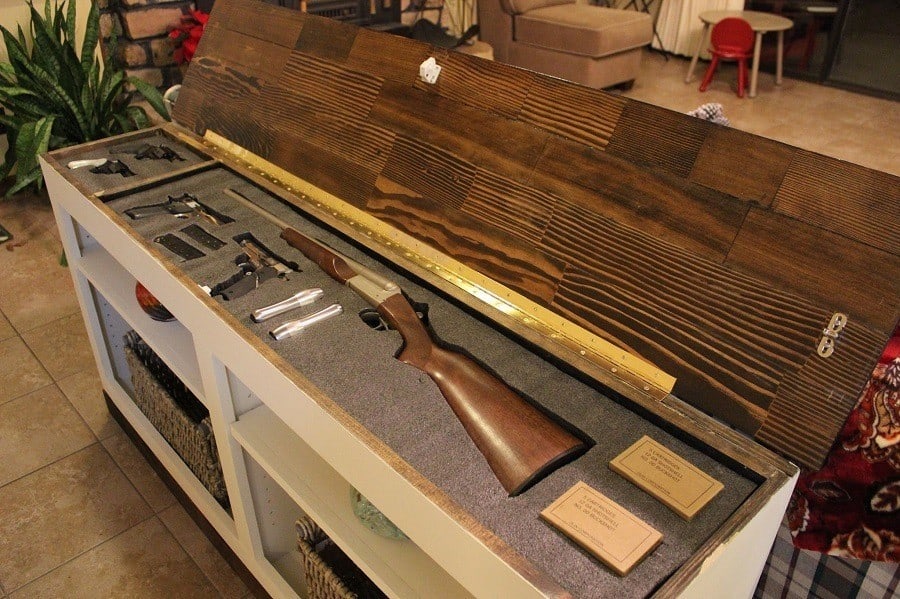
Shotguns are the most common type of home defense weapon used in the United States. But for a shotgun to be appropriate for home defense, it should be easily accessible. While also being safely stored to prevent access by unwanted users.
There’s a wide range of gun concealment furniture and also quick access gun safes that help this purpose. Since it is a shotgun, the safe will always be long and will have to be installed at some place.
Another thing that has to be considered when storing guns is if you have kids in the house. Since in that scenario, your shotgun should either be stored in an inconspicuous location or inside a strong gun safe.
If you are pressed on storing your shotgun inside a big gun safe. Make sure you have other arrangements for a quick-access home defense weapon. Like carrying a handgun in person. Additionally, states like California, Connecticut, New York and Massachusetts have strict gun storage laws.
As far as travel is concerned, carrying a shotgun on flights is subject to TSA guidelines. Which requires you to declare your firearm and store it inside a locked gun safe that cannot be carried as hand baggage.
For carrying your shotgun to the range, or as a truck gun. Each state has its own specific laws regarding transport of firearms inside a vehicle. The methods may range from locked gun safes to cheaper alternatives like a soft or carry case.
Conclusion
A shotgun is a high power firearm used for engaging targets at short range. Mostly within 100 yards maximum. Shotguns can be found in three major designs – the break action, semi-auto and pump action.
There’s a wide range of shotgun ammo ranging from buckshot with bigger pellets, birdshot with smaller pellets and slugs to work as single projectiles for longer range.
Different shotguns work for specific situations, and it is imperative you deduce it before buying. Or just go with a general purpose shotgun like the Remington 870 or Mossberg 500.


